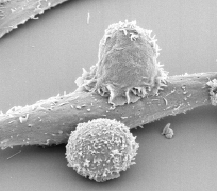In order to direct immune cells into the brain and eliminate tumors without endangering healthy tissue, UCSF researchers have created a “molecular GPS.”
It overcomes a significant drawback of CAR-T cancer treatments up to this point by becoming the first living cell therapy to go across the body to a particular organ. The researchers anticipate using the device in a clinical study the following year after it proved effective in mice.
The researchers used mice to demonstrate how immune cells may eradicate the lethal brain tumor known as glioblastoma and stop its recurrence. Additionally, they employed the cells to reduce inflammation in a multiple sclerosis animal model.
Living cells, especially immune cells, are adapted to move around the body, sense where they are and find their targets.
Wendell Lim, PhD
Their findings were published in the journal Science.
Brain cancer is the most common cause of cancer death in children, with almost 300,000 new cases identified annually in the United States.
Brain malignancies are among the most difficult cancers to cure due to their location. Chemotherapy and surgery are dangerous, and medications don’t always reach the brain.
In order to circumvent these issues, the researchers created a “molecular GPS” for immune cells that directed them using a “street address” for the tumor and a “zip code” for the brain.
They discovered the perfect molecular zip code in brevican, a protein that only occurs in the brain and aids in the formation of its jelly-like shape. They employed two proteins present in the majority of brain tumors for the street address.
The immune cells were primed to launch an attack only in the event that the investigators discovered brevican first, followed by either of the brain cancer proteins.
The immune cells readily found their way to the mouse’s brain after being injected into the bloodstream, where they destroyed a developing tumor. The bloodstream’s remaining immune cells remain quiescent, preventing the attack of any tissues outside the brain that just so happen to share the same protein “address.”
When the researchers implanted fresh tumor cells into the brain a hundred days later, enough immune cells remained to detect and eliminate the new tumor cells, suggesting that they might be able to stop any cancer cells from returning.
The brain-primed CAR-T cells were very, very effective at clearing glioblastoma in our mouse models, the most effective intervention we’ve seen yet in the lab,
t shows just how well the GPS ensured that they would only work in the brain. The same strategy even worked to clear brain metastases of breast cancer.
Milos Simic, PhD
Also Read: New studies investigate potential treatments for cancer and other illnesses
In a different experiment, the researchers engineered cells that carry anti-inflammatory chemicals to the brain in a mouse model of multiple sclerosis using the brain GPS system. The inflammation subsided after the modified cells once more arrived at their destination and delivered their message.
The researchers anticipate that people with other crippling disorders of the neurological system will soon be able to use this method.
Glioblastoma is one of the deadliest cancers, and this approach is poised to give patients a fighting chance,
Between cancer, brain metastases, immune disease and neurodegeneration, millions of patients could someday benefit from targeted brain therapies like the one we’ve developed.
Hideho Okada
Source: University of California San Francisco – News
Journal Reference: Simic, Milos S., et al. “Programming Tissue-sensing T Cells That Deliver Therapies to the Brain.” Science, 2024, DOI: 10.1126/science.adl4237.
Last Modified:







